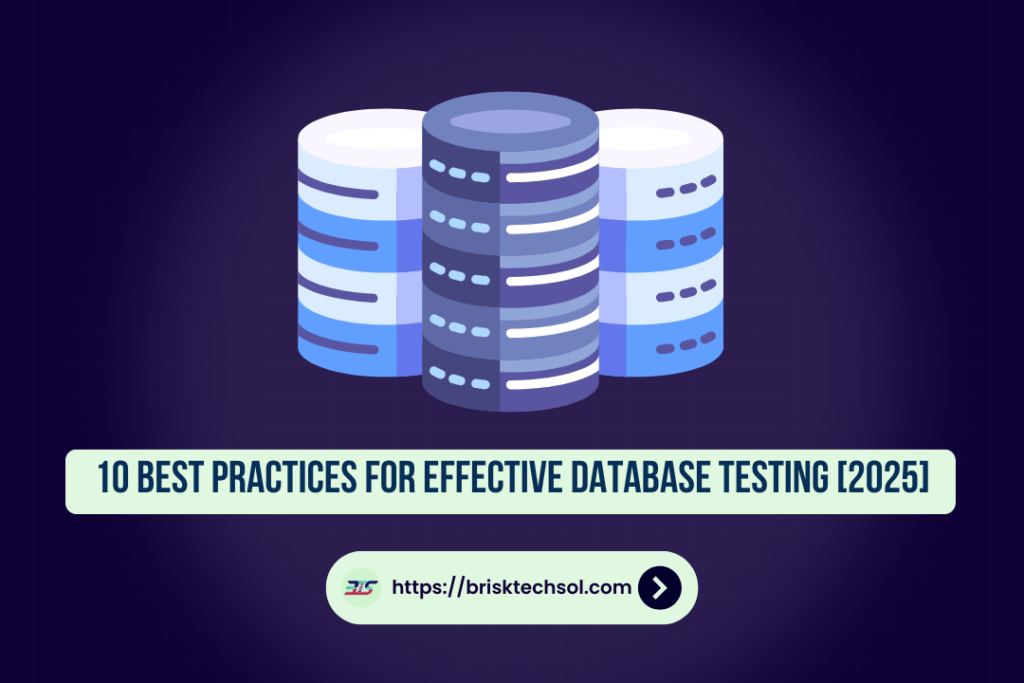In this article, we will guide you through 10 best practices for effective database testing. These practices will help ensure your data remains accurate, secure, and performs optimally under all conditions. Whether you’re a seasoned QA professional or a developer looking to improve your testing processes, these insights will help you build a more reliable application.
Overlooking Database Testing Can Be Costly
While many development teams excel at UI, API, and integration testing, database testing is often sidelined. Neglecting this crucial aspect can lead to:
- Data corruption that jeopardizes business operations.
- Security vulnerabilities that expose sensitive information.
- Performance bottlenecks that frustrate users.
- Compliance issues that can result in legal consequences.
Without comprehensive testing, these problems can escalate, leading to system failures and a damaged reputation.
What Is Database Testing and Why Is It Important?
Database testing involves validating the database to ensure that it meets its design and performance specifications. This type of testing goes beyond checking individual queries it involves verifying data integrity, schema correctness, security measures, and performance under various loads.
Why Is Database Testing Crucial?
- Data Accuracy: Ensure that every piece of data is correct and stored in the right place.
- Data Integrity: Verify relationships between tables and maintain consistency through constraints and transactions.
- Performance: Identify slow-running queries and optimize them to enhance application speed.
- Security: Detect vulnerabilities that might expose sensitive information or allow unauthorized access.
- Compliance: Ensure that the database adheres to industry regulations and standards.
By thoroughly testing your database, you minimize the risk of future errors and create a more reliable, scalable system.
How to Plan an Effective Database Testing Strategy?
Planning is the foundation of successful testing. A comprehensive database testing strategy should be well-documented and cover every aspect of your database operations.
Steps to Create a Robust Testing Plan:
- Define Objectives:
- Clarify Goals: Determine what aspects of the database need testing data integrity, performance, security, and so on.
- Scope: Decide on the areas that require testing, including stored procedures, triggers, and schema design.
- Clarify Goals: Determine what aspects of the database need testing data integrity, performance, security, and so on.
- Identify Dependencies and Risks:
- Dependencies: Recognize interactions with external systems, APIs, and other databases.
- Risks: Identify potential pitfalls such as data loss, performance issues, and security vulnerabilities.
- Dependencies: Recognize interactions with external systems, APIs, and other databases.
- Develop Test Cases:
- Comprehensive Coverage: Create test cases that cover common use cases, edge cases, and error scenarios.
- Prioritization: Rank tests based on their importance and potential impact on the system.
- Comprehensive Coverage: Create test cases that cover common use cases, edge cases, and error scenarios.
- Test Environment Setup:
- Replicate Production: Set up a test environment that mirrors your production environment as closely as possible.
- Isolated Data: Use anonymized or synthetic data instead of live production data to avoid privacy issues.
- Replicate Production: Set up a test environment that mirrors your production environment as closely as possible.
- Tools and Resources:
- Automation Tools: Identify and deploy tools for automated testing, such as SQLUnit or DbFit.
- Monitoring Tools: Use performance monitoring tools to keep track of query execution and system load.
- Automation Tools: Identify and deploy tools for automated testing, such as SQLUnit or DbFit.
Benefits of a Detailed Testing Plan:
- Consistency: Ensures that tests are repeatable and reliable.
- Efficiency: Saves time by clearly defining what to test and how to test it.
Risk Mitigation: Helps identify potential issues early in the development cycle.
How Do You Validate Data Integrity and Consistency?
Ensuring data integrity is essential for any database system. Data integrity refers to the accuracy and consistency of data over its lifecycle. This is critical for maintaining the trustworthiness of your application’s output.
Key Steps to Validate Data Integrity:
- Primary and Foreign Keys:
- Primary Keys: Confirm that every table has a unique primary key.
- Foreign Keys: Ensure that foreign keys properly enforce relationships between tables.
- Primary Keys: Confirm that every table has a unique primary key.
- Constraints:
- Unique Constraints: Verify that fields meant to be unique (like email addresses) are not duplicated.
- Check Constraints: Validate that values meet specific conditions (e.g., age must be a positive number).
- Unique Constraints: Verify that fields meant to be unique (like email addresses) are not duplicated.
- Referential Integrity:
- Cascading Actions: Check that cascading updates and deletes work as expected.
- Orphan Records: Ensure no records exist that violate defined relationships.
- Cascading Actions: Check that cascading updates and deletes work as expected.
- Data Consistency:
- Transaction Management: Validate that transactions either fully complete or roll back, preserving the original state.
- Synchronization: Ensure that data remains consistent across distributed systems or multiple databases.
- Transaction Management: Validate that transactions either fully complete or roll back, preserving the original state.
Practical Tips:
- Use SQL Queries: Write and run queries to compare expected versus actual data in tables.
- Automate Checks: Incorporate data integrity checks into your automated testing suite.
Periodic Audits: Regularly review your database schema and relationships to catch any drift from expected behavior.
How Can You Effectively Test Database Functions and Procedures?
Modern databases rely heavily on stored procedures, functions, and triggers to enforce business logic and automate tasks. Testing these components is critical to ensure they perform as expected under all scenarios.
Steps to Test Database Functions:
- Test CRUD Operations:
- Create: Validate that data is inserted correctly.
- Read: Ensure that data retrieval meets expectations.
- Update: Confirm that modifications are applied correctly.
- Delete: Verify that records are removed as intended.
- Create: Validate that data is inserted correctly.
- Stored Procedures:
- Edge Case Testing: Run procedures with both typical and boundary inputs.
- Error Handling: Ensure that procedures gracefully handle unexpected or erroneous inputs.
- Parameter Validation: Check that input parameters are properly sanitized to prevent SQL injection.
- Edge Case Testing: Run procedures with both typical and boundary inputs.
- Triggers and Functions:
- Execution Order: Confirm that triggers fire in the correct sequence.
- Conditional Logic: Test that functions return correct values under various conditions.
- Performance: Monitor the impact of triggers on database performance, especially in high-load scenarios.
- Execution Order: Confirm that triggers fire in the correct sequence.
Example Checklist for Testing Functions:
- Ensure that all input parameters are validated.
- Verify that the output matches expected results for known inputs.
- Test for performance under both normal and heavy load conditions.
- Confirm that error messages are clear and actionable.
How Do You Enhance Database Performance with Load Testing?
Performance issues can severely impact user experience and lead to system downtime. Load testing helps you understand how your database behaves under stress and enables you to optimize query performance.
Key Strategies for Load Testing:
- Simulate Real-World Load:
- Concurrent Users: Mimic the behavior of multiple users accessing the database simultaneously.
- Peak Conditions: Test during simulated peak traffic to identify performance bottlenecks.
- Concurrent Users: Mimic the behavior of multiple users accessing the database simultaneously.
- Monitor Query Performance:
- Execution Plans: Analyze execution plans to identify slow-running queries.
- Indexing: Review and optimize indexes to speed up data retrieval.
- Caching: Utilize caching strategies to reduce the load on the database.
- Execution Plans: Analyze execution plans to identify slow-running queries.
- Performance Metrics:
- Response Time: Track the time it takes for queries to execute.
- Throughput: Measure the number of transactions processed in a given time.
- Resource Utilization: Monitor CPU, memory, and I/O usage during load tests.
- Response Time: Track the time it takes for queries to execute.
Tools and Techniques:
- JMeter: A popular tool for simulating heavy loads and measuring performance metrics.
- Custom Scripts: Develop scripts that replicate user behavior under different conditions.
- Profiling Tools: Use database profiling tools to monitor resource usage and pinpoint slow queries.
Benefits of Load Testing:
- Scalability Insights: Understand how your database scales with increased usage.
- Bottleneck Identification: Identify and resolve issues before they affect production.
Performance Tuning: Make informed decisions about index creation, query optimization, and hardware upgrades.
How Can You Secure Your Database Against Potential Threats?
Security should never be an afterthought. With data breaches and cyber attacks on the rise, testing your database for vulnerabilities is more critical than ever.
Key Security Testing Measures:
- SQL Injection Prevention:
- Parameterized Queries: Always use parameterized queries to safeguard against SQL injection.
- Input Sanitization: Validate and sanitize all user inputs to prevent malicious code execution.
- Parameterized Queries: Always use parameterized queries to safeguard against SQL injection.
- Access Control:
- Role-Based Access Control (RBAC): Ensure that users have the minimum necessary privileges.
- User Authentication: Implement strong authentication mechanisms (e.g., multi-factor authentication).
- Role-Based Access Control (RBAC): Ensure that users have the minimum necessary privileges.
- Data Encryption:
- At Rest: Encrypt sensitive data stored in the database.
- In Transit: Use secure protocols (such as TLS/SSL) to protect data during transmission.
- At Rest: Encrypt sensitive data stored in the database.
- Regular Audits and Monitoring:
- Log Analysis: Regularly review database logs for unusual activity.
- Security Patches: Keep your database management system updated with the latest security patches.
- Log Analysis: Regularly review database logs for unusual activity.
- Vulnerability Scanning:
- Automated Scans: Use tools to scan for known vulnerabilities in your database system.
- Penetration Testing: Conduct regular penetration tests to simulate attacks and identify weaknesses.
- Automated Scans: Use tools to scan for known vulnerabilities in your database system.
Best Practices for Database Security Testing:
- Incorporate security tests as part of your continuous integration (CI) pipeline.
- Document and remediate any vulnerabilities found during testing.
- Educate your development team on secure coding practices and database security standards.
Why Is Automating Database Testing a Game-Changer?
Manual testing is both time-consuming and prone to human error, especially when repetitive tasks are involved. Automation in database testing not only increases efficiency but also ensures consistency across test runs.
Advantages of Automated Database Testing:
- Consistency: Automated tests run the same way every time, reducing variability.
- Speed: Tests are executed faster, allowing for more frequent testing cycles.
- Reusability: Once written, automated test scripts can be reused across different environments.
- Early Detection: Continuous testing helps catch issues early in the development cycle, reducing the cost and effort needed for fixes.
Tools for Automating Database Testing:
- SQLUnit: For unit testing of database logic.
- DbFit: A tool designed to facilitate database testing in a business-readable format.
- Jenkins/CI Pipelines: Integrate automated tests into your continuous integration pipelines to ensure regular execution.
- Selenium: Although known for web testing, it can be paired with database validation to check data after front-end interactions.
Implementation Tips:
- Start Small: Begin automating the most repetitive and critical test cases.
- Modular Scripts: Write modular test scripts to ease maintenance and scalability.
Integrate with CI/CD: Ensure that your automated tests are part of the deployment pipeline to catch issues before they reach production.
How Does Schema Validation Enhance Database Reliability?
A well-structured schema is the backbone of a reliable database. Schema validation ensures that your database design adheres to best practices and meets application requirements.
Key Areas for Schema Validation:
- Table Structures:
- Column Definitions: Ensure that columns are correctly defined with appropriate data types and constraints.
- Normalization: Verify that the database is normalized to avoid data redundancy and maintain consistency.
- Column Definitions: Ensure that columns are correctly defined with appropriate data types and constraints.
- Constraints:
- Primary Keys: Confirm that every table has a unique primary key.
- Foreign Keys: Ensure that relationships between tables are properly enforced.
- Unique and Check Constraints: Validate that these constraints are correctly implemented.
- Primary Keys: Confirm that every table has a unique primary key.
- Indexing:
- Performance: Check that indexes exist for columns that are frequently used in queries.
- Maintenance: Regularly review and optimize indexes to avoid performance degradation.
- Performance: Check that indexes exist for columns that are frequently used in queries.
Benefits of Schema Validation:
- Prevents Structural Flaws: Early detection of schema errors can save time and prevent data anomalies.
- Improves Query Performance: Properly indexed and structured tables yield faster query results.
- Enhances Data Integrity: Well-defined constraints and relationships reduce the risk of corrupt data.
Practical Steps for Schema Validation:
- Use automated tools or scripts to compare schema definitions between development and production environments.
- Regularly review and update your schema based on evolving business requirements.
- Involve both developers and database administrators in the schema design and review process.
9. How Do You Manage Test Data Without Compromising Privacy?
Using production data in testing environments can be risky due to privacy and compliance concerns. Instead, it’s best to generate realistic test data that mimics production scenarios while protecting sensitive information.
Best Practices for Test Data Management:
- Data Masking:
- Replace sensitive data with masked or dummy data in non-production environments.
- Use tools that automatically anonymize sensitive information while preserving the data structure.
- Replace sensitive data with masked or dummy data in non-production environments.
- Synthetic Data Generation:
- Create synthetic datasets that closely resemble your production data.
- Use open-source libraries or dedicated software to generate varied and comprehensive test data.
- Create synthetic datasets that closely resemble your production data.
- Data Refresh and Versioning:
- Regularly update test data to reflect current production conditions.
- Maintain version control on test data sets to ensure consistency across test runs.
- Regularly update test data to reflect current production conditions.
- Environment Isolation:
- Ensure that test environments are isolated from production to prevent accidental data leaks.
- Use containerization or virtual environments to create safe testing spaces.
- Ensure that test environments are isolated from production to prevent accidental data leaks.
Advantages of Proper Test Data Management:
- Compliance: Avoids potential legal and privacy issues related to handling sensitive production data.
- Realism: Synthetic data that mirrors production allows for more accurate testing scenarios.
Flexibility: Easily modify and extend test data to cover new use cases or edge cases.
10. How Can You Ensure Reliable Backup and Recovery Testing?
A robust backup and recovery strategy is essential to protect your data against accidental loss, corruption, or malicious attacks. Testing these processes ensures that you can recover data quickly and with minimal disruption.
Steps to Test Backup and Recovery Procedures:
- Regular Backups:
- Schedule frequent automated backups.
- Test the backup process regularly to confirm that backups are completed without errors.
- Schedule frequent automated backups.
- Recovery Scenarios:
- Simulate various disaster scenarios to test the effectiveness of your recovery plan.
- Validate that backups can be restored in both full and partial recovery modes.
- Simulate various disaster scenarios to test the effectiveness of your recovery plan.
- Version Control and Change Tracking:
- Use version control systems for database schema changes.
- Keep a log of changes to quickly identify and revert problematic updates.
- Use version control systems for database schema changes.
- Testing and Documentation:
- Maintain clear documentation of backup and recovery procedures.
- Regularly conduct drills to ensure that your team is prepared in the event of a disaster.
- Maintain clear documentation of backup and recovery procedures.
Best Practices:
- Create a detailed disaster recovery plan and update it frequently.
- Monitor backup logs and conduct audits to ensure consistency.
- Ensure that your recovery tests cover both planned and unexpected scenarios.
Key Takeaways
- Plan Thoroughly: A detailed testing strategy lays the foundation for effective database testing.
- Validate Consistency: Ensure data integrity with proper keys, constraints, and transaction management.
- Test Functionality: Comprehensive testing of CRUD operations, stored procedures, and triggers is essential.
- Measure Performance: Regular load testing and query optimization can significantly enhance performance.
- Prioritize Security: Implement measures to protect against SQL injection and unauthorized access.
- Automate: Leverage automation to reduce human error and improve efficiency.
- Validate Schemas: Regularly review and update your database schema to maintain structural integrity.
- Manage Test Data: Use anonymized or synthetic data to simulate real-world conditions without risking privacy.
- Backup and Recovery: Regularly test backup and recovery procedures to ensure data safety.
Continuous Improvement: Regularly audit and update your processes to adapt to new challenges.









